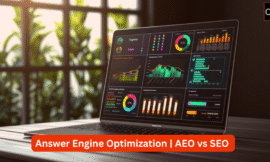Search behaviour is evolving fast as millions rely on AI tools like ChatGPT, Bard and Perplexity for direct answers daily. Yet SEO still anchors brands online. While AI search provides quick summaries, SEO ensures websites remain the trusted source for facts. Businesses that balance AI-friendly content with classic SEO strategies stay visible across Google, Bing and AI chat tools. In 2025, the smartest marketers know both must work together. Here we will explain why AI search is booming, how SEO remains strong, and how Online dot Marketing helps you adapt your content for the future. The next evolution of search rewards brands that invest in clear, helpful, well-structured pages supported by authority, trust and expert knowledge that both users and AI systems trust equally.
What is AI Search?
AI search uses generative AI to deliver direct answers by pulling information from trusted web sources, summarising it instantly for users through chatbots, AI Overviews and smart voice assistants. This process reduces traditional link clicks but depends heavily on quality, updated website content.
- Uses large language models to process queries accurately.
- Pulls verified data to generate contextually relevant answers.
- Power smart assistants like Alexa, Siri and Gemini daily.
- Enhances zero-click experience with concise summaries.
- Depends on up-to-date, high-quality web content to stay accurate.
Why AI Search is Popular
More people want fast, reliable answers every day, so AI search popularity is growing sharply, and it delivers instant results for voice search queries, zero-click searches and long conversational questions. Brands must learn how this trend works and adapt strategies properly to stay visible. The rise of smart assistants and chat-based AI is changing search forever. Businesses ignoring AI search risk losing organic reach. Smart marketers align SEO with AI-ready content, monitoring how search habits change. Voice search, local answers and predictive responses all fall under AI search trends brands must study. A strong balance of SEO and AI adaptation is now necessary for digital growth.
Where SEO Fits In
Without websites, AI search engines can’t function because they rely on high-quality, trustworthy content. SEO ensures your site provides clear, credible and structured information that AI models check, interpret and cite for billions of queries every day. This section should be about 200 words by adding context on how pages, backlinks, trust signals and proper on-page structure help AI bots. SEO keeps information fresh, accurate and easy to crawl, so AI answers stay reliable. When brands ignore SEO basics, they miss chances to appear in AI Overviews, voice results or smart assistants. Strong SEO makes sure your site remains visible in all future AI search experiences too.
AI Search vs. Traditional SEO
SEO ranks pages using keywords, trusted backlinks and strong E-E-A-T signals to build authority. Meanwhile, AI search extracts direct snippets and quick facts from that same content, and both methods work together, supporting visibility in traditional results and AI chat experiences alike.
| Feature | SEO | AI Search |
| Goal | Rank pages for queries | Deliver direct answers |
| Method | Optimize pages, links | Pull snippets, summaries |
| Content | Full pages, authority | Short facts, structured data |
| User Result | Click to site | Zero-click answer |
| Connection | Feeds AI with data | Uses SEO-optimized content |
Adapting Content for AI Search
- Use schema markup to help AI read your site correctly and cite your facts easily in AI results with confidence.
- Add FAQs and HowTo sections to cover real user questions clearly so AI can pull direct answers fast.
- Write clear, concise answers that match real queries so search engines feature your facts in AI Overviews and snippets.
- Focus on topic clusters and related questions so your site becomes an authority that AI trusts for multiple search intents.
- Update content frequently with new data, verified sources and refreshed sections to keep your pages AI-ready and accurate.
Benefits of Blending SEO & AI Readiness
Websites optimised for people-first search stay visible in Google, Bing and AI tools. Trust signals, clarity and relevance win both clicks and citations.
- Strong trust signals increase AI search trust and rankings by showing search bots your site is credible, authoritative and worth citing in summaries and answers across AI experiences.
- Clear content helps AI generate direct answers easily because short, structured text makes it simple for language models to extract facts correctly and match user questions well.
- Updated pages feed fresh facts to AI engines so answers stay relevant, match current trends and boost your site’s chances of ranking in new AI Overviews.
- Author profiles build E-E-A-T credibility by proving real expertise, authority and trust signals, which AI search systems use to judge whether to cite your pages.
- Structured data makes AI snippets possible by helping crawlers read sections properly, understand context and show your site’s answers cleanly in voice, chat and zero-click results.
- Good UX supports both SEO and AI needs by keeping content readable, accessible and easy for AI bots to interpret structure, headings and signals.
- Monitoring keeps your site AI-ready and accurate by catching broken pages, outdated info or gaps that could block AI search visibility or voice assistant answers.
Common Mistakes to Avoid
- Ignoring structured data
- Thin, generic content
- Outdated pages with no updates
- Weak backlinks or fake authorship
- Not monitoring AI snippets or AI citations
Future Trends in AI Search
Expect more zero-click answers, conversational queries and predictive results shaping search ahead. Sites with trusted data, strong authority and clear relevance will remain top sources for AI engines. Brands must keep content updated, structured and trustworthy to stay visible.
How to Measure Success
Track featured snippets, AI answers, zero-click impressions and branded mentions in AI chat to see where your site appears. Combine these new AI signals with classic SEO KPIs like keyword rankings, organic clicks, engagement and conversions. Together they show a complete performance snapshot. Measuring both SEO and AI search results keeps your strategy balanced. Use tools like Google Search Console, Ahrefs or Semrush for tracking and also check how voice assistants display your content. Look at click-through rates for featured snippets too. This helps brands adjust content, fix gaps and stay competitive in AI chat and organic search together. Reviewing these metrics every month ensures you stay ahead.
Real Brand Example
A mid-size publisher wanted to adapt to AI search. They updated old articles, added clear FAQs, applied proper schema markup, improved author bylines and built E-E-A-T signals. This helped them gain more AI citations, higher zero-click mentions and improved organic traffic and visibility across search engines. This success shows how practical SEO and AEO steps bring measurable results.
Final Thoughts
AI search is booming and shaping how people find information fast, but SEO is very much alive and continues evolving daily. Brands that combine smart SEO with AI-friendly strategies stay visible across search results and AI answers. Online dot Marketing helps you create a future-proof search strategy blending both approaches to keep your site strong, trusted and ready for tomorrow’s search demands.





